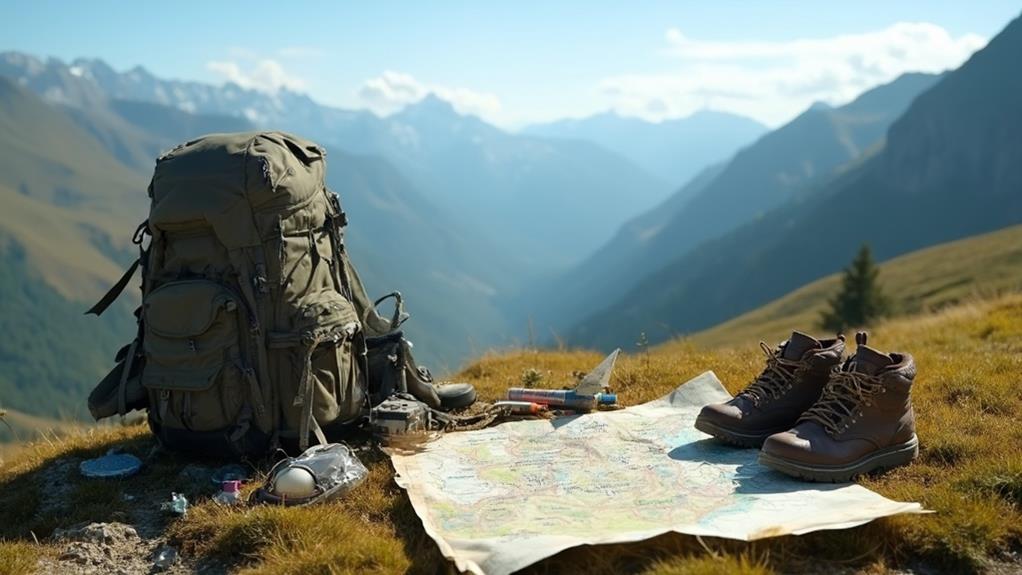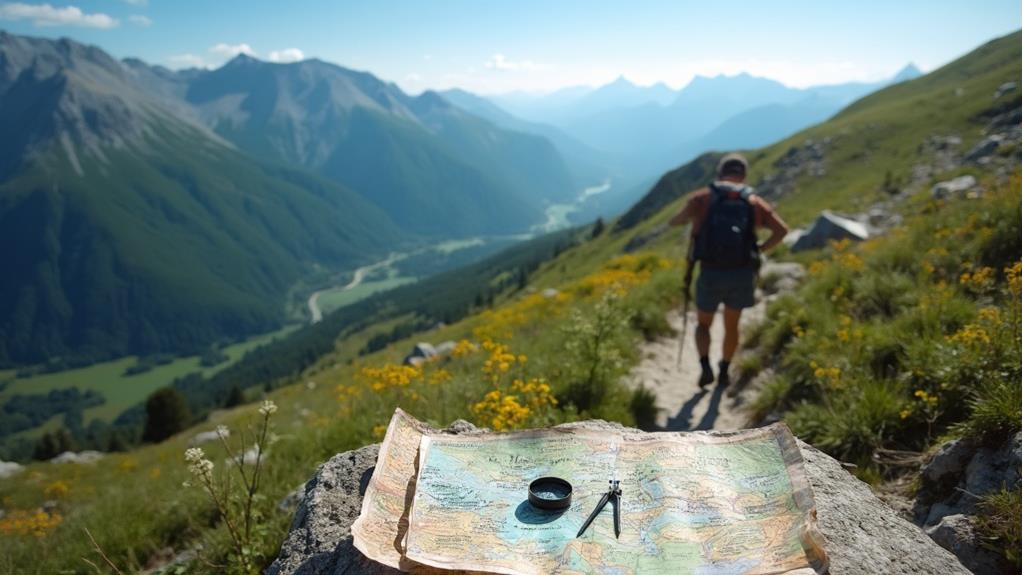Preparing for your first fell walk is an exciting journey into the heart of nature. Begin by meticulously planning your route using maps and selecting well-trafficked paths known for their safety. Equip yourself with sturdy, waterproof boots and dress in moisture-wicking layers to tackle unpredictable weather. A well-packed daypack is essential; include a map, compass, fully charged phone, water, snacks, and a first aid kit. Monitor weather forecasts and familiarize yourself with navigation skills for a confident adventure. Make sure to stay hydrated and consider snacks for sustained energy. Explore further to discover all the tips to enhance your fell walking experience.
Key Takeaways
- Select a popular, safe route and inform someone of your plan and return time.
- Wear layered clothing and waterproof hiking boots for comfort and protection.
- Carry a daypack with navigation tools, a charged phone, and a first aid kit.
- Check reliable weather forecasts and prepare for unexpected changes.
- Pack high-energy snacks and at least 2 liters of water per person.
Route Research and Planning
Starting on a fell walk begins with meticulous route research and planning, laying the groundwork for a safe and enjoyable adventure. For beginners, selecting popular routes known for their safety and the availability of assistance can be particularly advantageous. These routes not only offer the reassurance of established paths but also provide a supportive environment with helpful signage and occasional fellow walkers who can offer guidance.
Familiarizing yourself with the chosen route is crucial. Utilizing a detailed map, note key reference points such as landmarks, junctions, and elevation changes. Equally important is hazard identification; understanding potential challenges like steep inclines, slippery surfaces, or areas prone to sudden weather changes can greatly enhance your preparedness.
Be sure to take into account shorter walking options that allow flexibility in case of adverse weather or personal fatigue. Monitoring weather forecasts leading up to your walk and adjusting your plans accordingly guarantees that you avoid unnecessary risks.
For added safety, inform someone of your planned route and expected return time, especially essential if you're walking alone or traversing remote areas. Such preparation forms the backbone of a successful and memorable fell walking experience.
Essential Gear and Clothing

Once you've meticulously planned your route, equipping yourself with the right gear becomes the next step in ensuring a rewarding fell walking experience.
Start with investing in high-quality hiking footwear—specifically, waterproof boots that offer excellent ankle support and comfort. Breaking them in before your first walk is vital to avoid painful blisters.
Next, focus on clothing layers, which play a pivotal role in adapting to the unpredictable weather conditions often encountered on the fells.
Begin with a moisture-wicking, breathable base layer to keep you dry and comfortable. Add a fleece for insulation, providing warmth without bulk, and top it off with a waterproof jacket to shield against rain and wind.
Opt for lightweight, durable trousers designed for outdoor activity, featuring quick-drying properties and ample pockets for convenience.
A well-stocked daypack is essential. Include navigation tools like a detailed map and compass, alongside a charged mobile phone for emergencies.
Hydration and energy are key, so pack water and snacks. Don't forget a basic first aid kit and a waterproof cover to protect your belongings from unexpected downpours.
With these essentials, you're well-prepared for a safe and enjoyable journey.
Weather and Safety Tips
When setting out for a fell walk, prioritizing weather and safety is paramount to guarantee both an enjoyable and secure experience. Begin by consulting reliable weather forecasts, such as the Mountain Weather Information Service, to steer clear of potentially poor visibility or hazardous conditions. These forecasts provide essential insights into the day's climate, helping you plan appropriately.
However, given the nature of the fells, be prepared for unexpected changes that may occur. Even on a clear day, conditions can shift rapidly, requiring adaptability in your walking plans.
Summer offers the advantage of longer daylight hours, allowing more flexibility. Nevertheless, always consider real-time conditions and adjust your route if necessary. Familiarizing yourself with the unique challenges of various fells, such as those in Striding Edge and Sharp Edge, adds another layer of preparedness. These areas can present distinct difficulties that demand respect and caution.
Ensure to plan exit routes in advance, allowing for a swift and safe return should the weather deteriorate. Inform someone of your intended route and expected return time to keep safety at the forefront.
Navigation Skills

Mastering wayfinding skills is a cornerstone of successful fell walking, guaranteeing not only your safety but also enriching your overall experience. Basic map reading skills are essential, enabling you to interpret symbols, contours, and the map's scale to assess distances and elevation changes accurately. Understanding these elements allows you to visualize the terrain and prepare for any challenges that may arise during your journey.
Equally important is compass usage, which aids in orienting your map and determining directions, particularly in areas where visibility is limited. This skill is invaluable when traversing through unfamiliar landscapes shrouded in mist or fog.
Using laminated OS maps such as OL4, OL5, OL6, and OL7 is advisable, as they withstand wet conditions and maintain clarity even in inclement weather.
For a more modern approach, consider integrating mobile apps like the Lake District Maps Offline App into your wayfinding toolkit. These apps provide real-time location tracking, complementing traditional map reading and compass usage by offering additional reassurance and accuracy.
To build confidence and competence, regularly practice these wayfinding skills in familiar areas before venturing into more demanding fell walks. This preparation guarantees a safe and enjoyable exploration of the stunning landscapes.
Food and Hydration
Having honed your navigation skills, attention turns to the essential aspects of sustenance and hydration, equally important for a successful fell walk.
Thoughtful snack selection is critical, ensuring your energy levels remain consistent throughout the journey. Opt for meal deals and high-energy snacks like nuts, energy bars, and fresh fruit, which are both nourishing and easy to pack. Remember, the unpredictability of nature may lead to longer hikes than anticipated, so always pack a little extra to cover potential delays.
Hydration strategies are pivotal to maintaining peak performance and safety. It is advisable to carry at least 2 liters of water per person for a day hike. This amount should be adjusted upwards in warm weather or during particularly strenuous activities.
While hot flasks add comfort, relying solely on them is not recommended due to varying personal preferences. Instead, invest in a durable, refillable water bottle for both convenience and sustainability.
Lastly, if you have furry companions, consider their hydration needs as well, as natural water sources might not always be accessible. Checking for available water sources along your route can also inform how much water to carry, ensuring a well-prepared and enjoyable fell walk.
Frequently Asked Questions
How to Get Fit for Hill Walking for Beginners?
To enhance fitness for hill walking, beginners should follow training plans focusing on gradual terrain progression and strength exercises. Incorporate fitness tips such as regular aerobic activity and weighted backpack practice to build endurance and stability effectively.
How to Start Fell Walking?
Commence your fell walking journey by equipping yourself with essential gear, such as waterproof boots and appropriate clothing. Hone your navigation skills using maps and a compass. Start with manageable routes to build confidence and expertise.
What Does Hill Walking Involve?
Hill walking involves traversing upland terrains with challenging gradients. Essential gear includes sturdy boots, weather-appropriate clothing, and navigation tools. Safety tips emphasize preparedness for sudden weather changes, ensuring visibility, and carrying a first aid kit for emergencies.
What Is a Fell Walk?
Fell walking involves hiking in the UK's rugged, mountainous terrains, offering breathtaking views and tranquility. Essential gear includes sturdy footwear, weather-appropriate clothing, navigation tools, and a first aid kit, ensuring a safe and enriching outdoor adventure for all enthusiasts.
Conclusion
Starting on a first fell walk promises both adventure and serenity, contingent upon thorough preparation. Route research and planning guarantee efficient navigation, while essential gear and clothing provide comfort and protection. Adhering to weather and safety guidelines mitigates potential risks, and honing navigation skills enhances confidence in unfamiliar terrain. Adequate food and hydration sustain energy levels throughout the journey. By embracing these elements, the beauty and challenge of fell walking can be fully appreciated, offering an enriching outdoor experience.